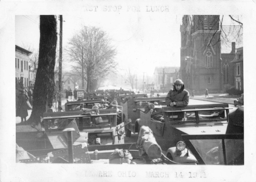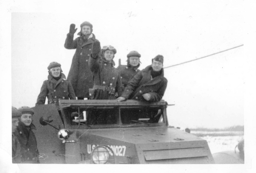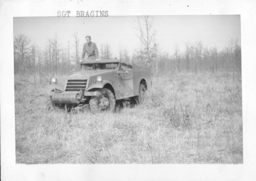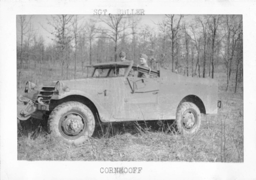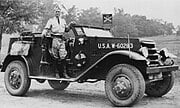M3A1 Scout Car
During the 1930s the Army experimented with a variety of wheeled armored cars to be used by mechanized cavalry for scouting missions.
The first variant was the M1 Scout Car tested in 1934, the M1 Scout Car was an open top four-wheel drive vehicle with a top speed of 50 mph and a crew of 4 with static mounted machine guns.
The second varian was the M2 Scout Car tested in 1935. Only 20 M2s were delivered to the Army.
The third variant was the M2A1 Scout Car, later redesignated the M3 Scout Car with a top speed of 60 mph. Sixty-four were produced, all being assigned to the 7th Cavalry Brigade.
The Final development of the series in 1939 was the M3A1 Scout Car with some external differences most notably widening the body over the fenders, the removal of the rear door and the addition of the front roller. Internally an improved engine and was fitted with the machine gun skate rail. 20,918 were produced and this was the only version to see service outside of the United States.
The M3A1 Scout Car was built by the White Motor Company of Cleveland, Ohio. The driver and vehicle commander were seated in the front cab, while seats in the rear compartment were provided for an additional six passengers. The “skate rail” ran around the rear compartment, upon which a .50 M2 (Browning) and one or two .30 M1919A4 machine guns could be mounted, while tripods were carried in the vehicle which could allow the guns to be dismounted for ground action if required. Introduced into service in mid-1939, the M3A1 was widely used by all branches of the US Army and was one of the first types of armored vehicle to be suppled to the United Kingdom in 1941. Eventually the British replaced the M3A1 with Daimler or Humber Scout Cars. The M3A1 was briefly used by the 1st and 2nd Marine Divisions but were found to by ill-suited for reconnaissance on tropical islands and were replaced by machine-gun armed 1/4-ton jeeps.
They were also used by the US Army in the North African Campaign and the invasion of Sicily. It was used in traditional cavalry roles, such as scouting and screening; also as an armored command vehicle. By mid-1943, the drawbacks of the design – it’s open top, poor off-road mobility, and poor armament were evident. During 1943, most US Army units replaced the M3A1 with the M8 armored car and similar M20 Utility Car.
The Soviet Union and a number of other Allied Armies also received stocks of the M3A1s throughout the war. Production of the M3A1 lasted until 1944, with 20,918 vehicles built. Post war M3A1s would continue to give useful service seeing employment int he 1948 Arab-Israeli War, the First Indo-China War,Laotian Civil War, Cambodian Civil War and the Algerian War.The 107th was issued the M3A1s and I have many pictures of these in service prior to the 107th being shipped to the ETO. I have attached examples of the various types developed.

